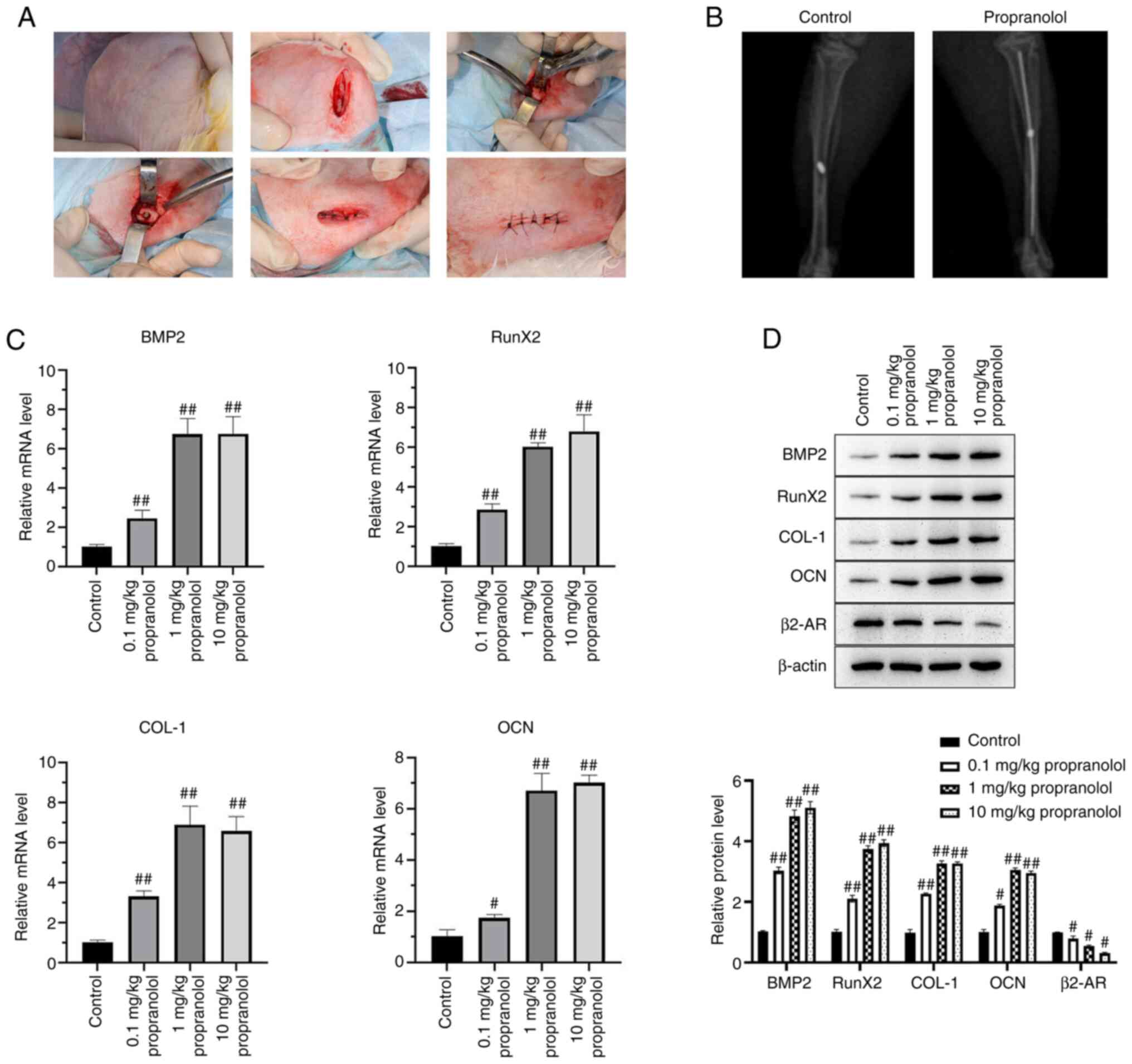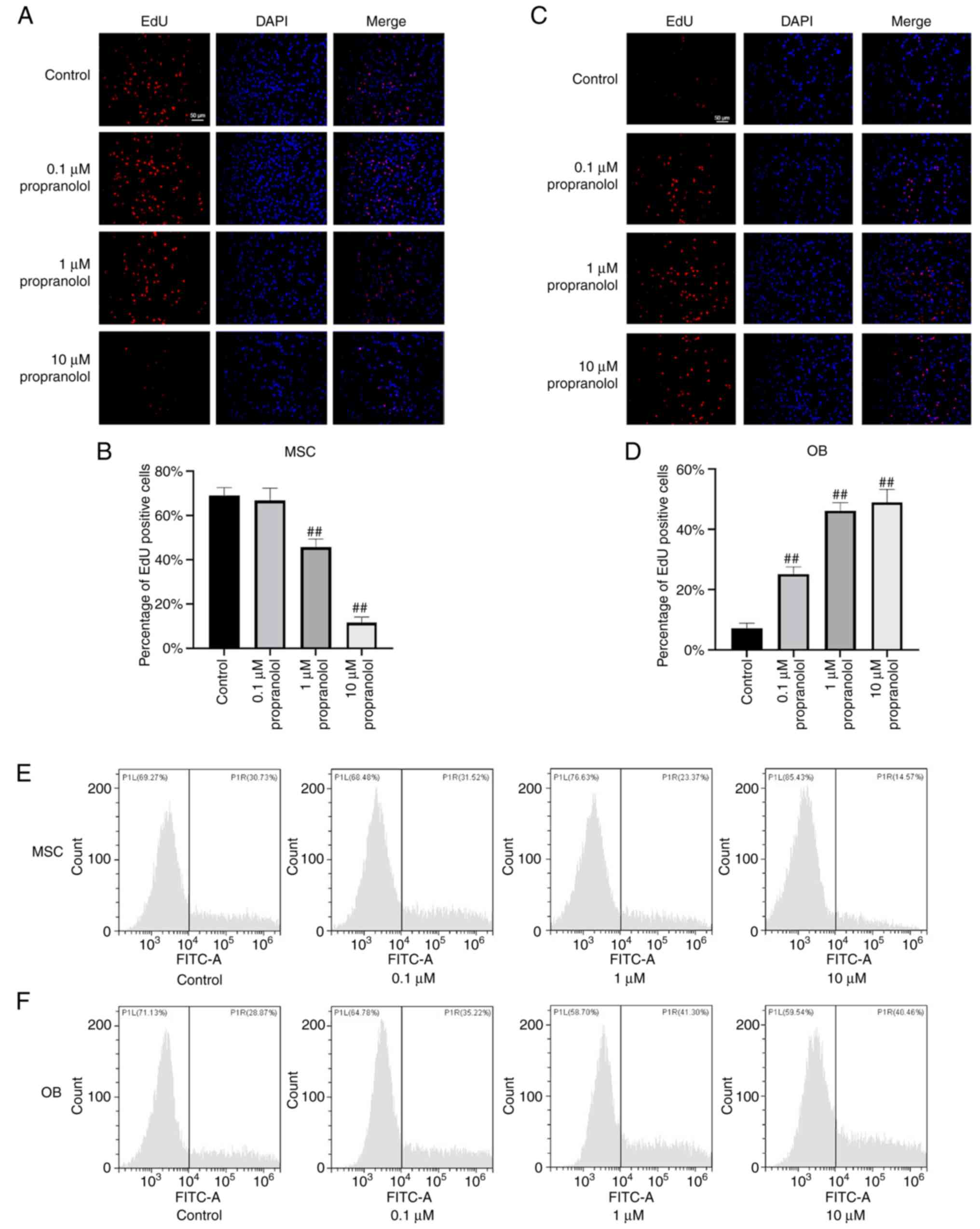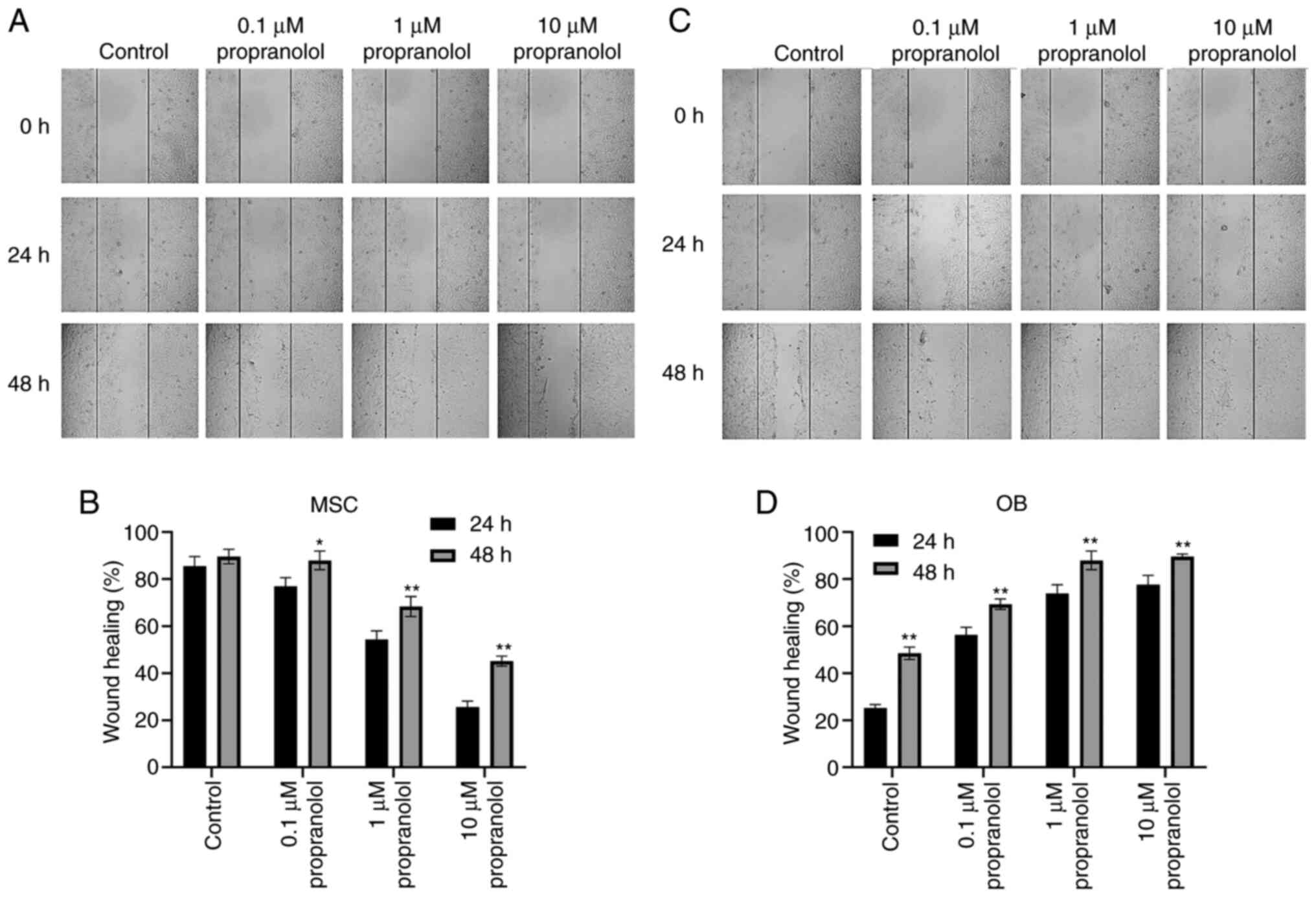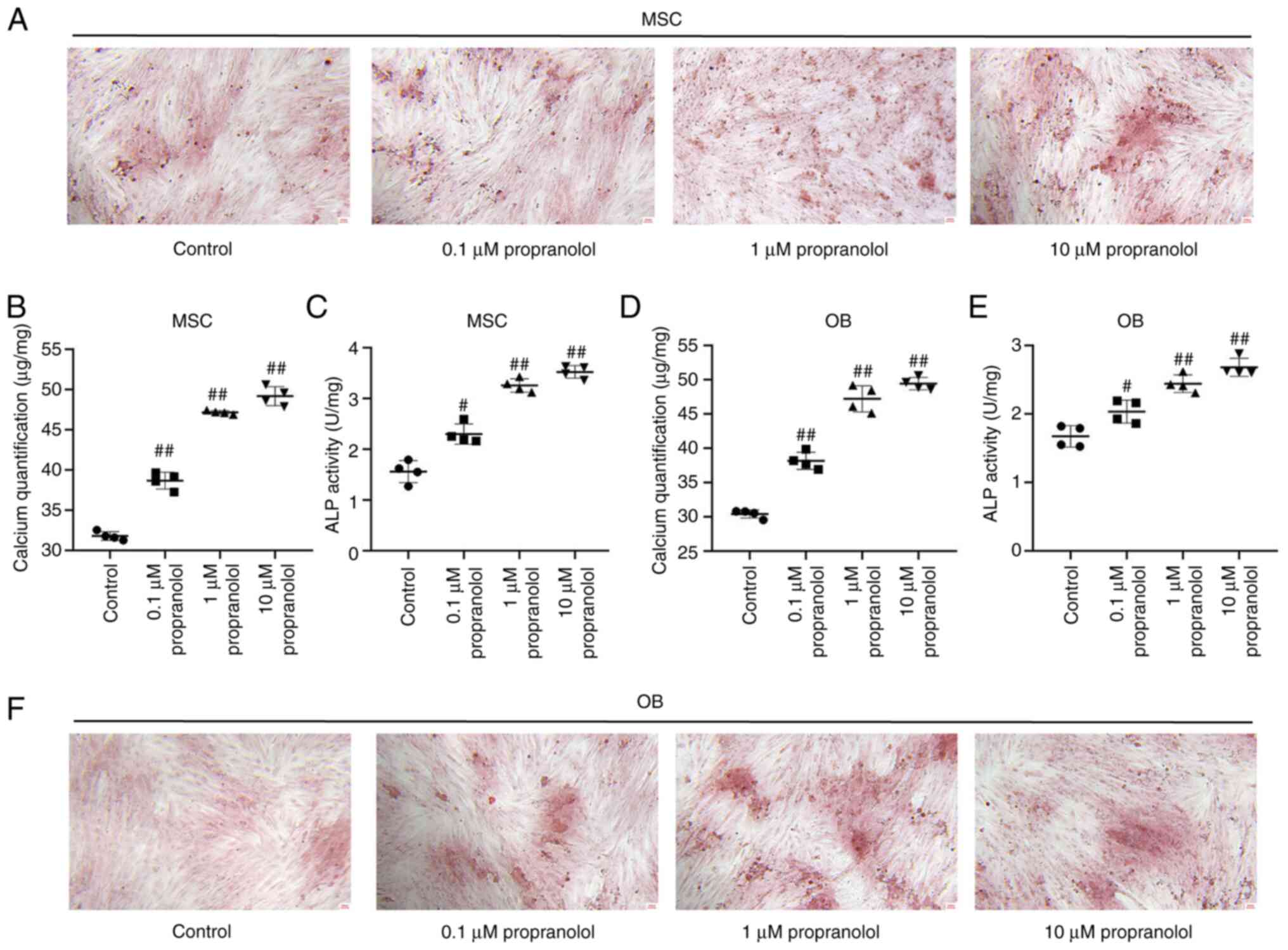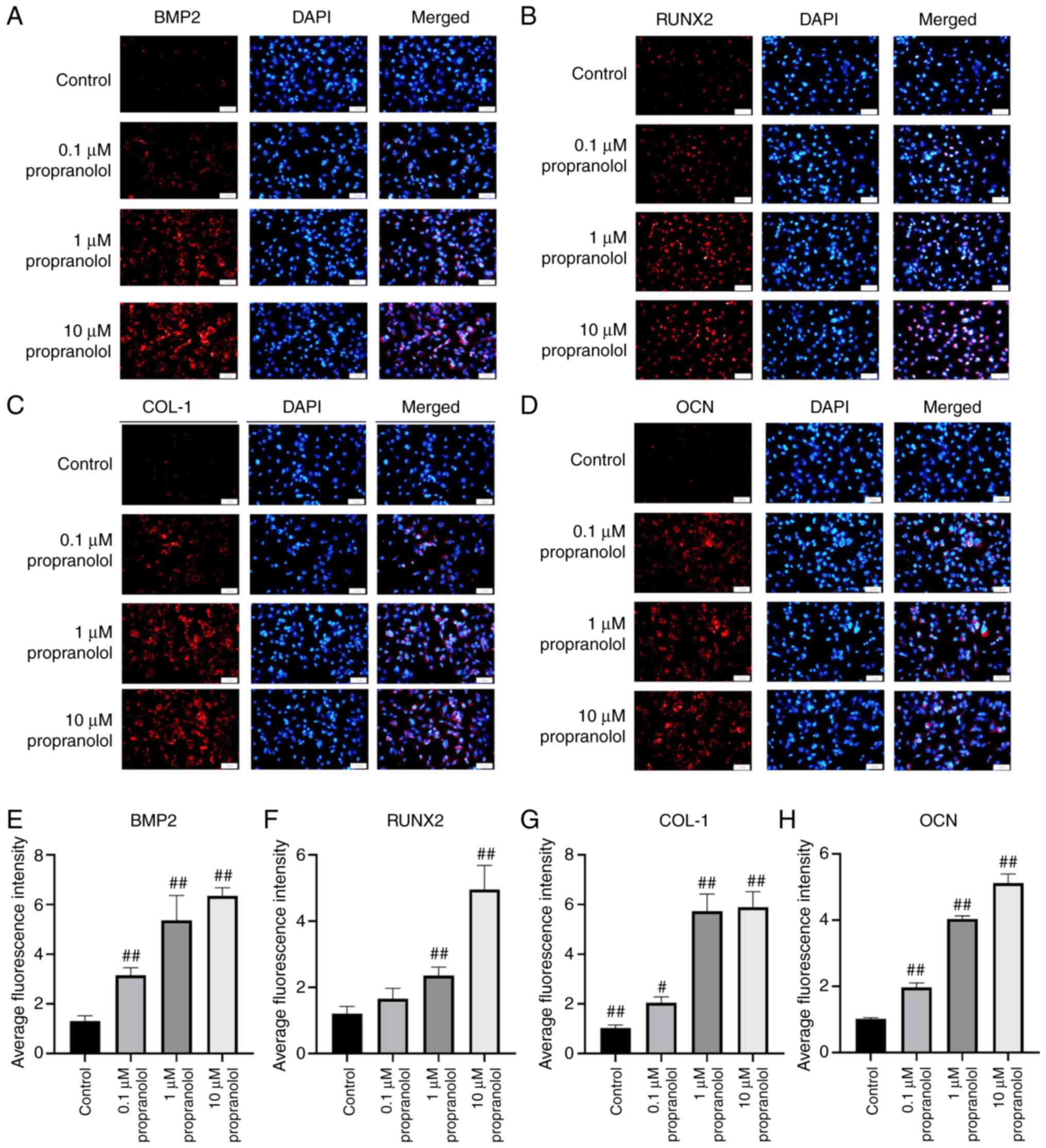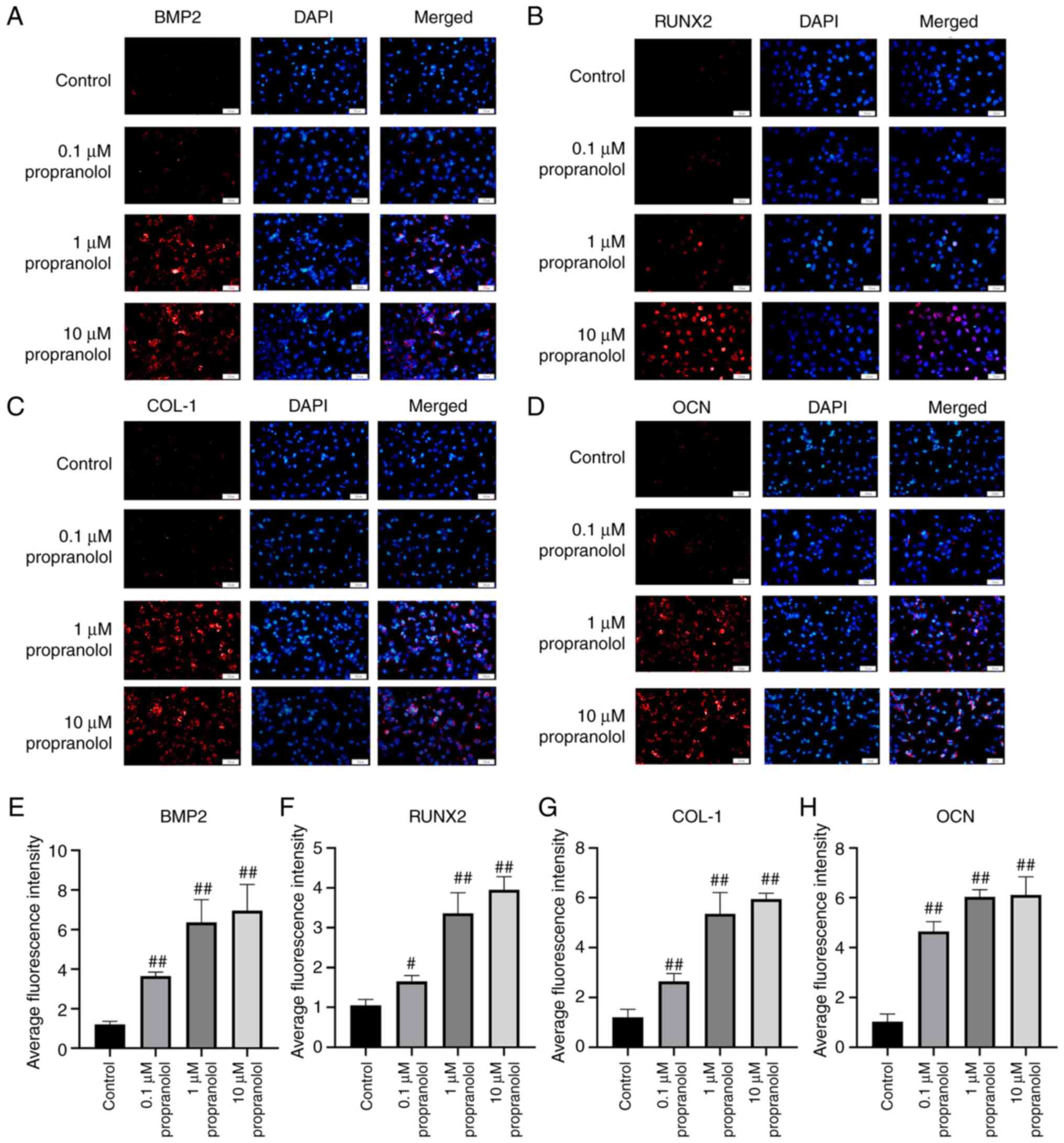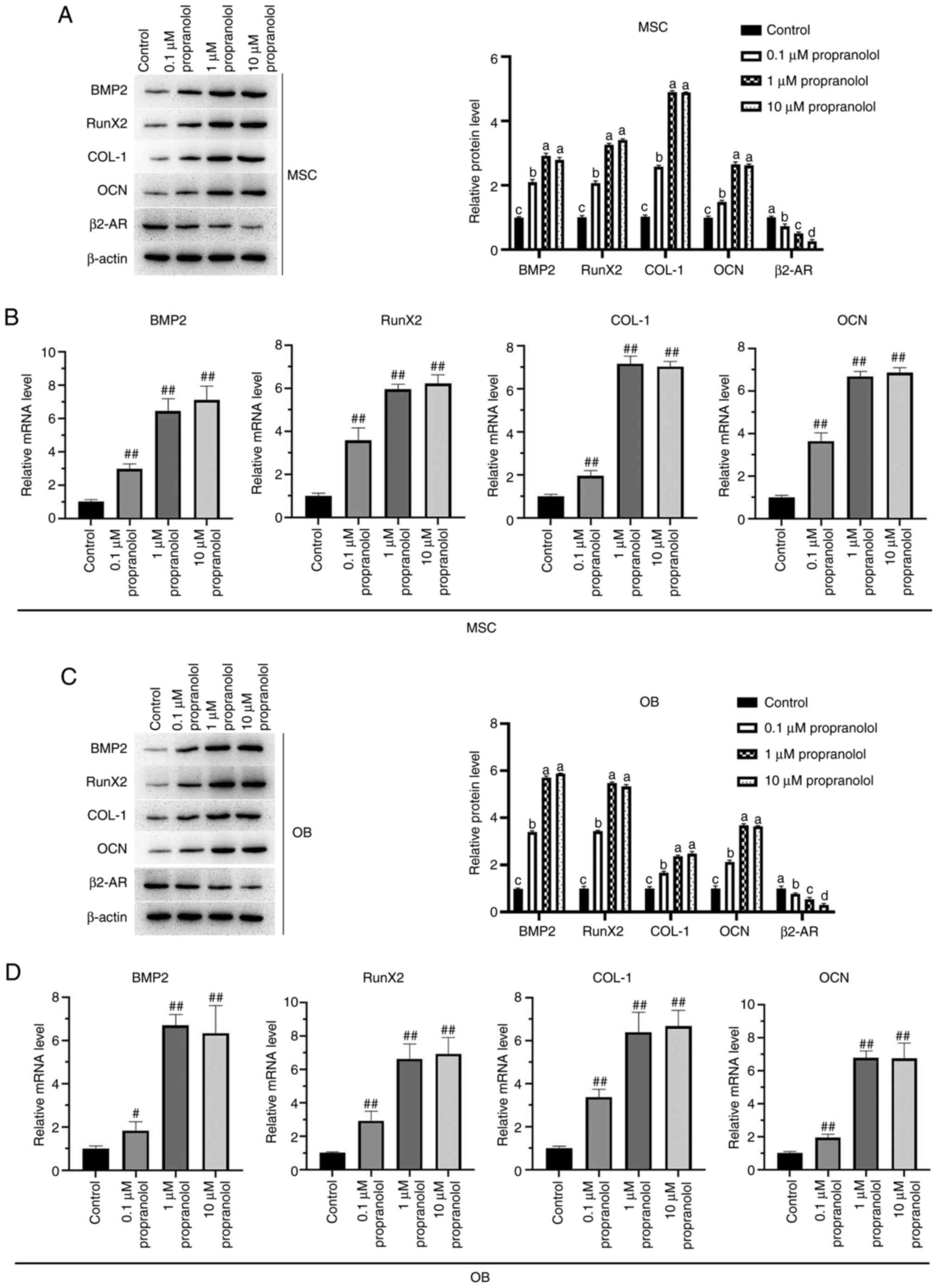Effect and mechanism of propranolol on promoting osteogenic differentiation and early implant osseointegration
- Authors:
- Published online on: August 19, 2021 https://doi.org/10.3892/ijmm.2021.5024
- Article Number: 191
-
Copyright: © Wu et al. This is an open access article distributed under the terms of Creative Commons Attribution License.
Abstract
Introduction
The occurrence of defects and deformity of bone tissue affects normal function and patient mobility (1). Severe cases may also result in psychological problems for patients (1). Multiple treatment options have been available in the past, including bone transplantation (either autologous or allogeneic) and the application of bone substitute materials (2). However, these methods have disadvantages, including rejection, high surgery costs, limited availability of bone, surgical trauma and complicated surgery (3), which result in limited clinical application. Two fundamental processes, bone formation and resorption, are involved in bone metabolic formation, which leads to decreased bone formation and mass; the application of β-receptor blocker propranolol significantly increases bone formation and bone mass (4,5).
As the effects of the sympathetic nervous system on bone remodeling and healing are complex and extensive, the underlying mechanism has not yet been fully recognized (6). Numerous experiments have investigated the effect of propranolol, a sympathetic blocker drug, on bone metabolism (7-9). To the best of our knowledge, however, few reports have illustrated the effect and mechanism of propranolol on proliferation of osteoblasts (OBs) and bone resorption of osteoclasts (OCs). OBs are derived from bone marrow-derived stem cells (BMSCs); OBs generate bone matrix during bone formation and release diverse bioactive substances to regulate and control the function of OCs (10,11). The stimulation of the sympathetic nervous system increases bone resorption and inhibits bone formation (12). This mechanism is associated with the activity of β2-adrenergic receptors (ARs) on OBs. Takeda et al (13) confirmed the presence of β2-ARs (and absence of other adrenoceptor subtypes) on OBs using reverse transcription-quantitative (RT-q)PCR and northern blotting in OBs. The most frequently administered drugs for hypertension and cardiovascular disease are β2-AR blockers. A previous study demonstrated the effect of β2-AR blockers in skeleton tissue (7). AR agonists promote bone resorption in mice (7). Systemic application of β-AR agonists decreases bone formation and mass, while the opposite result has been obtained using the β-AR blocker propranolol (14-16). To the best of our knowledge, however, the effects and regulatory mechanisms of propranolol on OBs and MSCs have not been fully explored. Therefore, the present study aimed to investigate whether the β-AR blocker propranolol promotes osteogenic differentiation of OBs and MSCs and enhances osseointegration of implants. OBs and MSCs were treated with propnaolol and the effects on cell proliferation and osteogenic differentiation and expression levels of osteoblast-associated proteins were detected. The present study also aimed to serve as a basis for further investigation of the mechanisms and effects of propranolol on implant osseointegration.
Materials and methods
Model establishment of implant osseointegration
The present animal experiment was performed in strict accordance with the regulations of the Ethics Committee of The Affiliated Hospital of Qingdao University (approval no. 201905036). A total of 32 healthy male New Zealand white rabbits (age, 5-6 months; weight ~3.5 kg), purchased from Qingdao Kangda Biological Technology Co., Ltd., were randomly divided into four groups (n=8/group): Control and low-(0.1 mg/kg), medium-(1 mg/kg) and high-dose propranolol (10 mg/kg). Rabbits were housed in sterile cages at 22°C and relative humidity of 50-60%, with 12 h light/dark cycle and free access to fodder and sterile water. All rabbits were acclimatized for 7 days before the operation. The anesthetic protocol was based on the Guide for Care and Use of Laboratory Animals (17). For anesthesia, xylazine hydrochloride (Jilin Province Huamu Animal Health Products Co., Ltd.) at 5 mg/kg was intramuscularly injected, followed by slow intravenous injection of 3% pentobarbital sodium (Sigma-Aldrich; Merck KGaA) at 24 mg/kg. Subcutaneous propoanolol injections were administered to the propranolol groups close to the surgical site preoperatively and an equal amount of normal saline was given to the control group for 28 successive days. Animals from each group subsequently received conventional surgical cavity preparation at the metaphysis of the tibia and two pure titanium implants (diameter, 3.4 mm; length; 8.0 mm) were inserted using an implant machine, one in each hindleg. On days 1-3 postoperatively, rabbits in each group were subcutaneously injected with buprenorphine hydrochloride (0.03 mg/kg) and doxycycline (3.2 mg/kg) and all healed well following surgery. Bone tissue binding to implants and absorption was observed through X-ray examinations. Then, rabbits in each group were sacrificed with a lethal dose of pentobarbital sodium (100 mg/kg) by intravenous injection and the intact tibia tissue was removed for subsequent experiments.
Extraction of MSCs
Isolation, culture and characterization of MSCs by cell surface markers detection and multi-lineage differentiation were performed as described previously by Farahzadi et al (8,9) and Fathi et al (18,19). Two laboratory rabbits were sacrificed and placed in 75% alcohol at room temperature for 15 min. Following separation on a clean bench under aseptic conditions, the tibia and femur of rabbits were placed into a beaker supplemented with PBS solution. The connective tissue and periosteum were removed immediately and the medullary cavity was washed with serum-free Dulbecco's modified eagle medium (DMEM) in a syringe and transferred into a centrifuge tube containing DMEM with 15% fetal bovine serum (FBS; both HyClone; Cytiva). When the medullary cavity turned white, ultrasound shaking at room temperature was performed at 240 × g for 5 min. The supernatant was discarded and high-glucose DMEM containing 15% FBS was added for cell suspension preparation. The samples were planted in a culture flask while being blown evenly. The culture medium was refreshed after 24 h and replaced every 2-3 days. Experiments were performed using third passage cells.
OBs isolation and culture
Isolation and culture of OBs were performed as described by Zhao et al (20). New Zealand rabbits were anesthetized by intravenous injection of pentobarbital sodium. The femur was subsequently removed and treated as aforementioned. The marrow was extracted from cleaned bones using DMEM supplemented with 15% FBS (HyClone; Cytiva) and incubated at 37°C with the medium replaced every 3 days. Once the cells were 50% confluent, the medium was replaced with DMEM containing 10% FBS and 1% penicillin + streptomycin (all HyClone; Cytiva). The cells were harvested after reaching 80-90% confluence using 0.25% trypsin. Experiments were performed using third passage cells.
Alizarin red staining
MSCs or OBs were cultured in DMEM containing 50 nM isoproterenol to simulate the effects of the sympathetic nerve (21). Following 24 h culture in DMEM, MSCs or OBs were cultured in osteogenic differentiation medium [5 mM β-glycerophosphate, 50 µg/ml ascorbic acid phosphate and 10 nM dexamethasone (all Sigma-Aldrich; Merck KGaA) in DMEM supplemented with 15% FBS] containing 50 nM isoproterenol and propranolol at different concentrations for 7-day induction at 37°C. Mineralized nodule alizarin red staining was subsequently performed. The original culture medium was discarded and PBS solution was used for three cycles of washing. Subsequently, 4% paraformaldehyde was used for fixation at room temperature for 20 min. Finally, the PBS solution was used to rinse cells. Cells were stained with 0.1% alizarin red dye for 30 min at 37°C, washed with running water and examined under a light microscope at ×200 magnification.
Alkaline phosphatase (ALP) staining
ALP staining was performed using the Gomori modified calcium-cobalt method, as previously described Huang et al (22). Following 3 weeks of induction, MSCs or OBs were inoculated into a petri dish (density, 2×104). Following removal of the original culture medium, cells were fixed with 95% ethanol at room temperature for 10 min, and then incubated with incubation buffer (5 3% sodium β-glycerophosphate, 5 2% sodium barbiturate, 10 distilled water, 10 2% CaCl2 and 1 ml 2% MgSO4) at 37°C for 4 h. Substrate solution was subsequently added to the petri dish, covered with hydrophobic membrane, incubated in a 37°C oven in the dark for 15 min and washed. Finally, dye solution was added for staining at room temperature for 3 min and samples were washed with running water and examined under a light microscope at ×200 magnification.
Cell proliferation assessment via EdU assay
EdU assay was performed as described by Shen et al (23). Briefly, MSCs or OBs (1×107) were cultured at 37°C in 6-well plates overnight. Cells were supplemented with EdU (10 µM) and incubated at 37°C for 2 h. After DMEM was removed, the cells were fixed with 1 ml 4% paraformaldehyde for 15 min at room temperature. After fixing medium was removed, cells were washed 3 times by adding 1 ml/well washing solution (3-5 min each). The washing solution was discarded. Then, 1 ml PBS containing 0.3% Triton X-100 was added to each well and incubated at room temperature for 10-15 min. The cells in each well were washed with 1 ml washing solution 1-2 times (3-5 min each). Then, endogenous peroxidase blocking solution was added for incubation at room temperature for 20 min to inactivate endogenous peroxidase activity. The cells were then rinsed with washing solution 3 times (2 min each) and visualized via a fluorescent microscope (Olympus Corporation) at ×200 magnification.
Cell proliferation assessment via flow cytometry
To determine cell proliferation, BrdU assay was performed as described by Heo et al (24). The MSCs or OBs (density, 1.5×105/ml) were inoculated in a 35-mm-diameter culture dish for 1 day at 37°C and synchronized in DMEM containing 0.4% FBS for 3 days until most cells entered the G0 phase. Cell proliferation was measured by a BrdU Staining kit for Flow Cytometry (cat. no. 8811-6600-42; Invitrogen; Thermo Fisher Scientific, Inc.), according to the manufacturer's instructions. Anti-BrdU FITC was added and incubated at 37°C for 40 min. The culture medium was discarded. The cells were collected into a flow tube and centrifugated at room temperature and 350 × g for 5 min. The supernatant was discarded. Each tube was fixed at room temperature with 1 ml 4% paraformaldehyde for 15 min and centrifugated at room temperature and 600 × g for 10 min. The supernatant was discarded. After washing, 2 glycine and 1 ml 0.5% triton was added to each tube and incubated at 37°C for 10 min. Following washing with PBS, the cells were resuspended and detected by BD LSRFortessa Flow Cytometer (BD Biosciences). Data was analyzed using CytExpert 2.3 software (Beckman Coulter, Inc.).
Wound healing assay
MSCs or OBs were seeded into 6-well plates at a cell density of 5×105/ml (500 µl/well) and cultured at 37°C for 24 h in RPMI-1640 complete growth medium (Invitrogen; Thermo Fisher Scientific, Inc.) to form an 80% confluent monolayer, which was scratched using the tip of a 10-µl pipetting gun. Cells were washed three times with PBS and incubated for 48 h (37°C; 5% CO2) in serum-free DMEM (HyClone; Cytiva). The cells were observed and photographed at 24 and 48 h under an inverted fluorescence microscope (Olympus Corporation) at ×200 magnification and quantification of scratch closure was evaluated using the wound healing measurement tool of ImageJ V1.8.0.112 (National Institutes of Health).
RT-qPCR
Total RNA was isolated from MSCs or OBs using TRIzol® reagent (Invitrogen; Thermo Fisher Scientific, Inc.). RT-qPCR was performed as described by Yin et al (25). RT was performed using a PrimeScript™ RT reagent kit (cat. no. RR047A; Takara Biotechnology Co., Ltd.) and a reaction system was established containing 2.2 µg RNA, 2.0 µl OligodT, 4.0 µl dNTP, 4.0 µl 5X buffer, 1.0 µl reverse transcriptase, 0.5 µl RNAase inhibitor and ≤20.0 µl RNAase-free ddH2O. The reaction conditions were as follows: 25°C for 5 min, 50°C for 15 min, 85°C for 5 min and 4°C for 10 min. qPCR was performed using a 2xT5 SYBR Green Fast qPCR Mix kit (cat. no. TSE202; TsingKe Biological Technology) according to the manufacturer's instructions. The reaction system contained 0.4 forward primer, 0.4 reverse primer, 10.0 SYBR Green and 5.2 µl H2O. The thermocycling conditions were as follows: 50°C for 2 min, 95°C for 10 min, 95°C for 30 sec and 60°C for 30 sec for 40 cycles. The 2−ΔΔCq method was used to calculate the relative expression levels (26). The primers were as follows (5′-3′): BMP2 forward, TGG CCC ATT TAG AGG AGA ACC and reverse, AGG CAT GAT AGC CCG GAG G; RUNX family transcription factor (RunX)2 forward, GAG ACT ACT GCC GAC CAC and reverse, TAC CTC TCC GAG GGC TAC C; collagen (COL)-1 forward, AGG GCC AAG ACG AAG ACA TC and reverse, AGA TCA CGT CAT CGC ACA ACA ; osteocalcin (OCN) forward, CTC ACA CTC CTC GCC CTA TT and reverse, CGC CTG GGT CTC TTC ACT AC; β2-AR forward, GGA CAA CCT CAT CCC TAA and reverse, GGA CAA CCT CAT CCC TAA and GAPDH forward, CAC ATG GCC TCC AAG GAG TAA and reverse, GTA CAT GAC AAG GTG CGG CTC. GAPDH was used as the control for normalization.
Protein expression level detection by western blot analysis
Western blotting was performed as described by Yin et al (25). Total protein was extracted from MSCs or OBs and bone tissue using RIPA reagent (Beyotime Institute of Biotechnology), and the concentration of extracted proteins was measured by BCA. Proteins (20 µg/lane) were isolated using SDS-PAGE (12% separating gel and 5% stacking gel) and transferred to polyvinylidene difluoride membranes. The membranes were blocked with 5% BSA (Beyotime Institute of Biotechnology) at 37°C for 1 h. The membranes were incubated with primary antibodies against BMP2, RunX2, COL-1, OCN and β2-AR overnight at 4°C, and using corresponding secondary antibodies incubated for 1.5 h at room temperature. Protein bands were detected by an enhanced chemiluminescent kit (Thermo Fisher Scientific, Inc.). The antibodies (all Chongqing Boai Madison Biotechnology Co., Ltd.) were as follows: BMP2 (1:500; cat. no. BM19970), RunX2 (1:500; cat. no. BM16360), COL-1 (1:500; cat. no. BM2319), OCN (1:500; cat. no. BM18692), β2-AR (1:500; cat. no. BMP0265), β-actin (1:2,000; cat. no. BMC026) and horseradish peroxidase-conjugated goat anti-rabbit IgG (1:2,000; cat. no. BMS014). Results were normalized yo β-actin. Western blots were quantified using Image J V1.8.0.112 (National Institutes of Health).
Immunofluorescence detection
Immunofluorescence detection was performed as described by Fathi et al (18). The MSCs or OBs were fixed with 4% paraformaldehyde at 4°C overnight. Paraffin-embedded sections (thickness, 4 µm) were baked at 60°C for 2 h, dewaxed and hydrated with xylene and alcohol. The sections were placed in citrate buffer solution (pH 6.0) for antigen repair, heated at 98°C in a microwave oven for 20 min and left to cool to room temperature. Three cycles of washing were performed with PBS (5 min each) followed by blocking with 5% BSA for 30 min at room temperature. The aforementioned primary antibodies (1:100) were added and incubated overnight at 4°C. Antibodies are described in western blot. Following reheating at 37°C for 30 min, PBS was used for washing (3 times; 5 min each). Corresponding secondary antibodies conjugated to Alexa594 (cat. no. R37117, 1:100; Thermo Fisher Scientific, Inc.) were added and incubated at room temperature for 1 h. PBS washing was repeated 3 times (5 min each). Nuclei were visualized by staining with 0.3 µM DAPI in the dark for 5-10 min at 37°C and then PBS was used to wash 3 times (1 min each). The sections were observed and photographed under a fluorescence microscope at ×200 magnification.
Statistical analysis
The experimental data were statistically analyzed using SPSS 23.0 software (IBM Corp.) and are expressed as the mean ± SD of three independent experiments. A paired t-test was used to compare groups before and after treatment. One-way ANOVA with Tukey's post hoc test was used for comparison between multiple groups. P<0.05 and P<0.01 were considered to indicate a statistically significant difference.
Results
Propranolol promotes osseointegration of implants
A New Zealand white rabbit model of implant osseointegration was established and injected with different doses of propranolol (0.1, 1.0 and 10.0 mg/kg). At 14 days post-surgery, bone tissue binding to implants and absorption were examined by X-ray scanning (Fig. 1A and B). Bone tissue samples of rabbits near the implants were collected and mRNA expression of BMP2, RunX2, COL-1, OCN, and β2-AR was detected by qPCR. Propranolol increased mRNA expressions of BMP2, RunX2, COL-1 and OCN and decreased that of β2-AR. The protein expression of BMP2, RunX2, COL-1, OCN and β2-AR was detected by western blotting; propranolol increased protein levels of BMP2, RunX2, COL-1 and OCN and decreased β2-AR levels. (Fig. 1C and D).
Propranolol inhibits proliferation of MSCs and promotes proliferation of OBs
To determine the effect of propranolol on proliferation of MSCs and OBs, MSCs and OBs were cultured in vitro using complete medium containing isoproterenol and treated with propranolol for 24 h. Cell proliferation was detected by EdU staining. The number of EdU-positive MSCs decreased markedly following the addition of propranolol and was lowest in the 10 µM propranolol group, indicating that propranolol inhibited proliferation of MSCs (Fig. 2A and B). In OBs, all concentrations of propranolol significantly promoted cell proliferation and the number of Edu-positive cells in the 1 and 10 µM propranolol groups were similar (Fig. 2C and D). These results suggested that propranolol inhibited proliferation of MSCs and promoted proliferation of OBs.
Propranolol inhibits migration of MSCs and promotes migration of OBs
The effect of propranolol on cell migration was detected by wound healing at 24 and 48 h. MSC migration was inhibited following the addition of propranolol to complete medium containing isoproterenol. Moreover, the healing rate of scratches was markedly lower in propranolol-treated MSCs compared with the control group; the higher the concentration, the lower the healing rate (Fig. 3A and B). Conversely, propranolol improved the healing rate of OBs and cell migration was higher than that of the control group (Fig. 3C and D). These results suggested that propranolol inhibited MSC migration and promoted OB migration.
Propranolol promotes osteogenic differentiation of MSCs and OBs
To determine the effect of propranolol on osteogenic differentiation of MSCs and OBs, MSCs and OBs cultured in vitro with osteogenic differentiation medium containing isoproterenol and propanolol. Following induction for 7 days, osteogenic differentiation of cells was detected by alizarin red staining. Propranolol promoted osteogenic differentiation of both MSCs and OBs and increased the number of intracellular calcium nodules following induction. The calcium content and ALP activity of cells treated with propranolol were significantly higher compared with the control group (Fig. 4A-F).
Regulatory effect of propranolol on osteogenesis-associated genes
To elucidate the osteogenic mechanism of propranolol in regulating MSCs (Fig. 5A-H) and OBs (Fig. 6A-H), expression levels of osteogenesis-associated genes BMP2, RunX2, COL-1, OCN and β2-AR were detected by immunofluorescence, RT-qPCR and western blotting. The findings demonstrated that propranolol significantly increased protein expression levels of BMP2, RunX2, COL-1 and OCN and decreased expression of β2-AR in a dose-dependent manner. The results of RT-qPCR and western blotting were consistent with those of immunofluorescence analysis, indicating that propranolol upregulated expression levels of osteogenesis-associated genes (BMP2, RunX2, COL-1 and OCN), thereby promoting osteogenic differentiation of MSCs and OBs (Fig. 7A-D).
Discussion
Early rapid osseointegration is a key factor for successful implantation but is limited by biological inertia, high elastic modulus and limited biological effects of the material surface (27). An effective technique to improve the performance of titanium implants and to promote and accelerate osseointegration has been the focus of research in recent years (28-30). Despite titanium and titanium alloy implants are widely used in the fields of dentistry and oral and maxillofacial surgery, postoperative infection and poor osseointegration remain obstacles to implant surgery (31). Drugs, such as zoledronic acid, osteoprotegerin, and kaempferol, also promote early osseointegration of implants (32-34).
As an integrated part of the autonomic nervous system of the human body, the sympathetic nervous system serves a key role in regulating homeostasis. Growing evidence has shown that the sympathetic nervous system is involved in bone remodeling (6,35). In 1977, Duncan and Shim (36) demonstrated that the surface of intraosseous vessels is covered with rich adrenergic nerve fibers by observing the bone tissue of rabbits using histochemistry and fluorescence electron microscopy. Mach et al (37) demonstrated that sympathetic nerve fibers are primarily located in the bone marrow cavity, favors areas of abundant blood flow and are rare in the periosteum. When the sympathetic nerve is excited, bone resorption is promoted and bone formation is decreased via β2-ARs on the surface of OBs (38). β2-AR has been visualized on the surface of human OBs by immunofluorescence and studies using β2-AR agonists indicated that they serve a role in inhibiting proliferation of OBs (38,39). Although regulation of sympathetic nerve on bone turnover via β2-ARs expressed on OBs has been demonstrated, little is known about the effect of β-AR blocker propranolol on osteogenic differentiation of OBs. In the study, propranolol promoted the proliferation and differentiation of OBs, which is consistent with previous studies (40,41).
Propranolol is a recognized drug for treatment of hypertension and cardiovascular disease (42-44). Propranolol is a non-selective β1 and β2-AR blocker that has been used since 1964 to treat coronary artery insufficiency (45). Propranolol competitively inhibits the action of epinephrine and norepinephrine on β1- and β2-ARs (46). Multiple studies have shown that propranolol inhibits expression of β2-AR (47,48). Previously, the effect of propranolol on bone metabolism has received attention (41,49,50). Minkowitz et al (49) reported that mineral deposition and bone formation increase in a rat model of surgical fracture treated with propranolol for 9 weeks. Bonnet et al (41) found that low-dose propranolol improved bone formation and prevented osteoclasts proliferation in ovariectomized rats. Epidemiological studies have also demonstrated that β2-AR blockers serve as potential candidate drugs for treatment of osteoporosis and fractures (51,52). β-blockers enhanced bone healing and improved bone metabolism (53). The present study investigated the effects of β-AR blocker propranolol on osteogenesis in an animal model. The results demonstrated that propranolol promoted osseointegration of implants in rabbits, which is consistent with conclusions of previous studies (7,50), suggesting that propranolol enhances bone regeneration and implant osseointegration.
No consensus on the mechanism of β2-AR in regulating osteogenesis and osteoclast has been reached. By investigating the osteogenic mechanism of MSCs, certain scholars have reported that β-AR activators inhibit osteogenesis of MSCs, while blockers promote osteogenesis of MSCs (54,55). The β-AR activator also inhibits the signaling pathway associated with osteogenesis by regulating expression of MEK and ERK1/2 phosphorylation, thereby inhibiting differentiation of BMSCs into osteoblast-like cells in vitro (56,57). The osteogenic capacity of MSCs has been established (58). MSCs serve as a source of osteochondral progenitors that invade bone sites, proliferate and differentiate into cartilage and bones (59). β-AR antagonists promote MSC osteogenesis (50,55). In the present study, propranolol promoted osteogenic differentiation of MSCs while inhibiting their proliferation. This may be due to inhibition of MSC proliferation during differentiation; this has been reported in previous studies, which illustrated that stem cell differentiation is inhibited but proliferation is promoted (60,61). Osteoblastic differentiation of cells is accompanied by upregulation of osteoblast marker genes, including BMP2, RunX2, COL-1 and OCN (62,63). The present study demonstrated that propranolol increased the mRNA and protein expression levels of BMP2, RunX2, COL-1 and OCN in tissue and cells and decreased expression of β2-AR in OBs and MSCs. The increased calcium content and ALP activity in propranolol-treated OBs and MSCs also indicated osteoblastic differentiation of cells. The findings provide a basis for further studies on the mechanisms underlying the regulatory effects of propranolol.
There effects and mechanisms of propranolol on osteogenesis at different concentrations are disputed (64). Smitham et al (2014) (65) demonstrated that low-dose propranolol (0.1 mg/kg) has little effect on bone defect healing, while Bonnet et al (2008) (41) suggested that high-dose propranolol (10-100 mg/kg) produces no additional positive effect on osteogenesis compared with low-dose propranolol. The present study demonstrated that the osteogenic effect of propranolol at medium (1 mg/kg) and high (10 mg/kg) doses was markedly enhanced compared with the low dose (0.1 mg/kg), whereas no superior effect was revealed in the high-compared with the medium-dose group. However, further investigation of the clinical use of propanolol in this context is required.
The present study demonstrated that the β-AR blocker propranolol promoted osteogenic differentiation of OBs and MSCs and enhanced osseointegration of implants by regulating expression levels of osteogenic-associated proteins, including BMP2, RunX2, COL-1, OCN and β2-AR. The present study therefore provided a novel insight into the application and regulatory mechanisms of propranolol.
Availability of data and materials
All data generated or analyzed during this study are included in this published article.
Authors' contributions
All authors contributed to study conception and design. YW wrote the manuscript. YW, QZ, BZ and XW performed experiments and collected and analyzed data. YW and XW reviewed and edited the manuscript. YW and XW confirm the authenticity of all the raw data. All authors read and approved the final manuscript.
Ethics approval and consent to participate
The present study was approved by the institutional ethical review committee of the Ethics Committee of The Affiliated Hospital of Qingdao University (approval no. 201905036).
Patient consent for publication
Not applicable.
Competing interests
The authors declare that they have no competing interests.
Acknowledgments
Not applicable.
Funding
The present study was supported by Open Project (grant no. 2017KB03) from State Key Laboratory of Military Stomatology, the Project QDFY + X2021002 and Project QDFY + X2021004 from the Affiliated Hospital of Qingdao University.
References
|
Yamakawa D, Kawase-Koga Y, Fujii Y, Kanno Y, Sato M, Ohba S, Kitaura Y, Kashiwagi M and Chikazu D: Effects of helioxanthin derivative-treated human dental pulp stem cells on fracture healing. Int J Mol Sci. 21:91582020. View Article : Google Scholar : | |
|
Warzecha J, Seebach C, Flinspach A, Wenger F, Henrich D and Marzi I: Effect of sonic hedgehog/β-TCP composites on bone healing within the critical-sized rat femoral defect. Exp Ther Med. 5:1035–1039. 2013. View Article : Google Scholar : PubMed/NCBI | |
|
Xu J, Hu X, Jiang S, Wang Y, Parungao R, Zheng S, Nie Y, Liu T and Song K: The application of multi-walled carbon nanotubes in bone tissue repair hybrid scaffolds and the effect on cell growth in vitro. Polymers (Basel). 11:2302019. View Article : Google Scholar | |
|
Banfi G, Lombardi G, Colombini A and Lippi G: Bone metabolism markers in sports medicine. Sports Med. 40:697–714. 2010. View Article : Google Scholar : PubMed/NCBI | |
|
Leffers D and Collins L: An overview of the use of bone scintigraphy in sports medicine. Sports Med Arthrosc Rev. 17:21–24. 2009. View Article : Google Scholar | |
|
Niedermair T, Straub RH, Brochhausen C and Grässel S: Impact of the sensory and sympathetic nervous system on fracture healing in ovariectomized mice. Int J Mol Sci. 21:21–24. 2020. View Article : Google Scholar | |
|
Tomlinson RE, Christiansen BA, Giannone AA and Genetos DC: The role of nerves in skeletal development, adaptation, and aging. Front Endocrinol (Lausanne). 11:6462020. View Article : Google Scholar | |
|
Farahzadi R, Mesbah-Namin SA, Zarghami N and Fathi E: L-carnitine effectively Induces hTERT gene expression of human adipose tissue-derived mesenchymal stem cells obtained from the aged subjects. Int J Stem Cells. 9:107–114. 2016. View Article : Google Scholar : | |
|
Farahzadi R, Fathi E and Vietor I: Mesenchymal stem cells could be considered as a candidate for further studies in cell-based therapy of alzheimer's disease via targeting the signaling pathways. ACS Chem Neurosci. 11:1424–1435. 2020. View Article : Google Scholar : PubMed/NCBI | |
|
Li X, Zheng Y, Hou L, Zhou Z, Huang Y, Zhang Y, Jia L and Li W: Exosomes derived from maxillary BMSCs enhanced the osteogenesis in iliac BMSCs. Oral Dis. 26:131–144. 2020. View Article : Google Scholar | |
|
Yu L, Wu Y, Liu J, Li B, Ma B, Li Y, Huang Z, He Y, Wang H, Wu Z and Qiu G: 3D culture of bone marrow-derived mesenchymal stem cells (BMSCs) could improve bone regeneration in 3D-printed porous Ti6Al4V scaffolds. Stem Cells Int. 2018:20740212018. View Article : Google Scholar : PubMed/NCBI | |
|
Lombardi G, Ziemann E, Banfi G and Corbetta S: Physical activity-dependent regulation of parathyroid hormone and calcium-phosphorous metabolism. Int J Mol Sci. 21:53882020. View Article : Google Scholar : | |
|
Takeda S, Elefteriou F, Levasseur R, Liu X, Zhao L, Parker KL, Armstrong D, Ducy P and Karsenty G: Leptin regulates bone formation via the sympathetic nervous system. Cell. 111:305–317. 2002. View Article : Google Scholar | |
|
Hamano S, Tomokiyo A, Hasegawa D, Yuda A, Sugii H, Yoshida S, Mitarai H, Wada N and Maeda H: Functions of beta2-adrenergic receptor in human periodontal ligament cells. J Cell Biochem. 2020.Online Ahead of Print. View Article : Google Scholar | |
|
Nijhuis LE, Olivier BJ, Dhawan S, Hilbers FW, Boon L, Wolkers MC, Samsom JN and de Jonge WJ: Adrenergic β2 receptor activation stimulates anti-inflammatory properties of dendritic cells in vitro. PLoS One. 9:e850862014. View Article : Google Scholar | |
|
Mauro LJ, Wenzel SJ and Sindberg GM: Regulation of chick bone growth by leptin and catecholamines. Poult Sci. 89:697–708. 2010. View Article : Google Scholar : PubMed/NCBI | |
|
National Research Council Committee for the Update of the Guide for the Care and use of Laboratory Animals: Guide for the Care and Use of Laboratory Animals The National Academies Collection: Reports funded by National Institutes of Health. National Academies Press; Washington, DC: 2011 | |
|
Fathi E, Valipour B, Sanaat Z, Nozad Charoudeh H and Farahzadi R: Interleukin-6, -8, and TGF-β secreted from mesenchymal stem cells show functional role in reduction of telomerase activity of leukemia cell via Wnt5a/β-catenin and P53 pathways. Adv Pharm Bull. 10:307–314. 2020. View Article : Google Scholar | |
|
Fathi E, Farahzadi R, Javanmardi S and Vietor I: L-carnitine extends the telomere length of the cardiac differentiated CD117+-expressing stem cells. Tissue Cell. 67:1014292020. View Article : Google Scholar | |
|
Zhao ZQ, Liu WL, Guo SB, Bai R and Yan JL: Mechanism of methylprednisolone-induced primary cilia formation disorder and autophagy in osteoblasts. Orthop Surg. 12:645–652. 2020. View Article : Google Scholar : PubMed/NCBI | |
|
Dasu MR, Ramirez SR, La TD, Gorouhi F, Nguyen C, Lin BR, Mashburn C, Stewart H, Peavy TR, Nolta JA and Isseroff RR: Crosstalk between adrenergic and toll-like receptors in human mesenchymal stem cells and keratinocytes: A recipe for impaired wound healing. Stem Cells Transl Med. 3:745–759. 2014. View Article : Google Scholar : PubMed/NCBI | |
|
Huang X, Zhu B, Wang X, Xiao R and Wang C: Three-dimensional co-culture of mesenchymal stromal cells and differentiated osteoblasts on human bio-derived bone scaffolds supports active multi-lineage hematopoiesis in vitro: Functional implication of the biomimetic HSC niche. Int J Mol Med. 38:1141–1151. 2016. View Article : Google Scholar : PubMed/NCBI | |
|
Shen C, Yang C, Xu S and Zhao H: Comparison of osteogenic differentiation capacity in mesenchymal stem cells derived from human amniotic membrane (AM), umbilical cord (UC), chorionic membrane (CM), and decidua (DC). Cell Biosci. 9:172019. View Article : Google Scholar : PubMed/NCBI | |
|
Heo SK, Noh EK, Gwon GD, Kim JY, Jo JC, Choi Y, Koh S, Baek JH, Min YJ and Kim H: LIGHT (TNFSF14) increases the survival and proliferation of human bone marrow-derived mesenchymal stem cells. PLoS One. 11:e01665892016. View Article : Google Scholar : PubMed/NCBI | |
|
Yin Y, Chen P, Yu Q, Peng Y, Zhu Z and Tian J: The effects of a pulsed electromagnetic field on the proliferation and osteogenic differentiation of human adipose-derived stem cells. Med Sci Monit. 24:3274–3282. 2018. View Article : Google Scholar : PubMed/NCBI | |
|
Livak KJ and Schmittgen TD: Analysis of relative gene expression data using real-time quantitative PCR and the 2(-Delta Delta C(T)) method. Methods. 25:402–408. 2001. View Article : Google Scholar | |
|
Chang B, Song W, Han T, Yan J, Li F, Zhao L, Kou H and Zhang Y: Influence of pore size of porous titanium fabricated by vacuum diffusion bonding of titanium meshes on cell penetration and bone ingrowth. Acta Biomater. 33:311–321. 2016. View Article : Google Scholar | |
|
Fares C, Hsu SM, Xian M, Xia X, Ren F, Mecholsky JJ Jr, Gonzaga L and Esquivel-Upshaw J: Demonstration of a SiC protective coating for titanium implants. Materials (Basel). 13:33212020. View Article : Google Scholar | |
|
Cardona MJ, Turner C, Ross C, Baird E and Black RA: An improved process for the fabrication and surface treatment of custom-made titanium cranioplasty implants informed by surface analysis. J Biomater Appl. 35:602–614. 2021. View Article : Google Scholar | |
|
Scarano A, Lorusso F, Orsini T, Morra M, Iviglia G and Valbonetti L: Biomimetic surfaces coated with covalently immobilized collagen type I: An X-ray photoelectron spectroscopy, atomic force microscopy, micro-CT and histomorphometrical study in rabbits. Int J Mol Sci. 20:7242019. View Article : Google Scholar | |
|
Gong T, Xie J, Liao J, Zhang T, Lin S and Lin Y: Nanomaterials and bone regeneration. Bone Res. 3:150292015. View Article : Google Scholar : PubMed/NCBI | |
|
Dikicier E, Karaçaylı Ü, Dikicier S and Günaydın Y: Effect of systemic administered zoledronic acid on osseointegration of a titanium implant in ovariectomized rats. J Craniomaxillofac Surg. 42:1106–1111. 2014. View Article : Google Scholar : PubMed/NCBI | |
|
Liu Y, Hu J, Liu B, Jiang X and Li Y: The effect of osteoprotegerin on implant osseointegration in ovariectomized rats. Arch Med Sci. 13:489–495. 2017. View Article : Google Scholar : PubMed/NCBI | |
|
Tsuchiya S, Sugimoto K, Kamio H, Okabe K, Kuroda K, Okido M and Hibi H: Kaempferol-immobilized titanium dioxide promotes formation of new bone: Effects of loading methods on bone marrow stromal cell differentiation in vivo and in vitro. Int J Nanomedicine. 13:1665–1676. 2018. View Article : Google Scholar | |
|
Carnagarin R, Matthews V, Zaldivia MTK, Peter K and Schlaich MP: The bidirectional interaction between the sympathetic nervous system and immune mechanisms in the pathogenesis of hypertension. Br J Pharmacol. 176:1839–1852. 2019. View Article : Google Scholar : | |
|
Duncan CP and Shim SS: J. Edouard Samson address: The autonomic nerve supply of bone. An experimental study of the intraosseous adrenergic nervi vasorum in the rabbit. J Bone Joint Surg Br. 59:323–330. 1977. View Article : Google Scholar : PubMed/NCBI | |
|
Mach DB, Rogers SD, Sabino MC, Luger NM, Schwei MJ, Pomonis JD, Keyser CP, Clohisy DR, Adams DJ, O'Leary P and Mantyh PW: Origins of skeletal pain: Sensory and sympathetic innervation of the mouse femur. Neuroscience. 113:155–166. 2002. View Article : Google Scholar | |
|
Mediero A, Wilder T, Shah L and Cronstein BN: Adenosine A2A receptor (A2AR) stimulation modulates expression of semaphorins 4D and 3A, regulators of bone homeostasis. Faseb J. 32:3487–3501. 2018. View Article : Google Scholar : PubMed/NCBI | |
|
Emet M, Ozcan H, Ozel L, Yayla M, Halici Z and Hacimuftuoglu A: A review of melatonin, its receptors and drugs. Eurasian J Med. 48:135–141. 2016. View Article : Google Scholar : PubMed/NCBI | |
|
Teong B, Kuo SM, Chen CH, Chen YK, Cheng ZJ and Huang HH: Characterization and human osteoblastic proliferation- and differentiation-stimulatory effects of phosphatidylcholine liposomes-encapsulated propranolol hydrochloride. Biomed Mater Eng. 24:1875–1887. 2014.PubMed/NCBI | |
|
Bonnet N, Benhamou CL, Malaval L, Goncalves C, Vico L, Eder V, Pichon C and Courteix D: Low dose beta-blocker prevents ovariectomy-induced bone loss in rats without affecting heart functions. J Cell Physiol. 217:819–827. 2008. View Article : Google Scholar | |
|
Srinivasan AV: Propranolol: A 50-year historical perspective. Ann Indian Acad Neurol. 22:21–26. 2019. View Article : Google Scholar : PubMed/NCBI | |
|
Woroń J, Siwek M and Gorostowicz A: Adverse effects of interactions between antidepressants and medications used in treatment of cardiovascular disorders. Psychiatr Pol. 53:977–995. 2019. View Article : Google Scholar | |
|
Zhou HM, Zhong ML, Wang RH, Long CL, Zhang YF, Cui WY and Wang H: Synergisms of cardiovascular effects between iptakalim and amlodipine, hydrochlorothiazide or propranolol in anesthetized rats. Zhongguo Ying Yong Sheng Li Xue Za Zhi. 31:532–540. 2015. | |
|
Stapleton MP: Sir James Black and propranolol. The role of the basic sciences in the history of cardiovascular pharmacology. Tex Heart Inst J. 24:336–342. 1997. | |
|
Wolter JK, Wolter NE, Blanch A, Partridge T, Cheng L, Morgenstern DA, Podkowa M, Kaplan DR and Irwin MS: Anti-tumor activity of the beta-adrenergic receptor antagonist propranolol in neuroblastoma. Oncotarget. 5:161–172. 2014. View Article : Google Scholar : | |
|
Bustamante P, Miyamoto D, Goyeneche A, de Alba Graue PG, Jin E, Tsering T, Dias AB, Burnier MN and Burnier JV: Beta-blockers exert potent anti-tumor effects in cutaneous and uveal melanoma. Cancer Med. 8:7265–7277. 2019. View Article : Google Scholar : PubMed/NCBI | |
|
Bravo-Calderón DM, Assao A, Garcia NG, Coutinho-Camillo CM, Roffé M, Germano JN and Oliveira DT: Beta adrenergic receptor activation inhibits oral cancer migration and invasiveness. Arch Oral Biol. 118:1048652020. View Article : Google Scholar | |
|
Minkowitz B, Boskey AL, Lane JM, Pearlman HS and Vigorita VJ: Effects of propranolol on bone metabolism in the rat. J Orthop Res. 9:869–975. 1991. View Article : Google Scholar : PubMed/NCBI | |
|
Wu H, Song Y, Li J, Lei X, Zhang S, Gao Y, Cheng P, Liu B, Miao S, Bi L, et al: Blockade of adrenergic β-receptor activation through local delivery of propranolol from a 3D collagen/polyvinyl alcohol/hydroxyapatite scaffold promotes bone repair in vivo. Cell Prolif. 53:e127252020. View Article : Google Scholar | |
|
Sato T, Arai M, Goto S and Togari A: Effects of propranolol on bone metabolism in spontaneously hypertensive rats. J Pharmacol Exp Ther. 334:99–105. 2010. View Article : Google Scholar | |
|
Sato T, Miyazawa K, Suzuki Y, Mizutani Y, Uchibori S, Asaoka R, Arai M, Togari A and Goto S: Selective β2-adrenergic antagonist butoxamine reduces orthodontic tooth movement. J Dent Res. 93:807–812. 2014. View Article : Google Scholar | |
|
Actis L, Gaviria L, Guda T and Ong JL: Antimicrobial surfaces for craniofacial implants: State of the art. J Korean Assoc Oral Maxillofac Surg. 39:43–54. 2013. View Article : Google Scholar | |
|
Jenei-Lanzl Z, Grässel S, Pongratz G, Kees F, Miosge N, Angele P and Straub RH: Norepinephrine inhibition of mesenchymal stem cell and chondrogenic progenitor cell chondrogenesis and acceleration of chondrogenic hypertrophy. Arthritis Rheumatol. 66:2472–2481. 2014. View Article : Google Scholar | |
|
Li H, Fong C, Chen Y, Cai G and Yang M: beta2- and beta3-, but not beta1-adrenergic receptors are involved in osteogenesis of mouse mesenchymal stem cells via cAMP/PKA signaling. Arch Biochem Biophys. 496:77–83. 2010. View Article : Google Scholar | |
|
Li XL, Zeng D, Chen Y, Ding L, Li WJ, Wei T, Ou DB, Yan S, Wang B and Zheng QS: Role of alpha- and beta-adrenergic receptors in cardiomyocyte differentiation from murine-induced pluripotent stem cells. Cell Prolif. 50:e123102017. View Article : Google Scholar | |
|
Xiao L, Pimental DR, Amin JK, Singh K, Sawyer DB and Colucci WS: MEK1/2ERK1/2 mediates alpha1-adrenergic receptor-stimulated hypertrophy in adult rat ventricular myocytes. J Mol Cell Cardiol. 33:779–787. 2001. View Article : Google Scholar | |
|
Marolt Presen D, Traweger A, Gimona M and Redl H: Mesenchymal stromal cell-based bone regeneration therapies: From cell transplantation and tissue engineering to therapeutic secretomes and extracellular vesicles. Front Bioeng Biotechnol. 7:3522019. View Article : Google Scholar : | |
|
Zhang W, Zhou L, Dang J, Zhang X, Wang J, Chen Y, Liang J, Li D, Ma J, Yuan J, et al: Human gingiva-derived mesenchymal stem cells Ameliorate Streptozoticin-induced T1DM in mice via suppression of T effector cells and Up-regulating Treg subsets. Sci Rep. 7:152492017. View Article : Google Scholar : PubMed/NCBI | |
|
Reumann MK, Linnemann C, Aspera-Werz RH, Arnold S, Held M, Seeliger C, Nussler AK and Ehnert S: Donor site location is critical for proliferation, stem cell capacity, and osteogenic differentiation of adipose mesenchymal stem/stromal cells: Implications for bone tissue engineering. Int J Mol Sci. 19:18682018. View Article : Google Scholar | |
|
Givogri MI, de Planell M, Galbiati F, Superchi D, Gritti A, Vescovi A, de Vellis J and Bongarzone ER: Notch signaling in astrocytes and neuroblasts of the adult subventricular zone in health and after cortical injury. Dev Neurosci. 28:81–91. 2006. View Article : Google Scholar | |
|
Masaoutis C and Theocharis S: The role of exosomes in bone remodeling: Implications for bone physiology and disease. Dis Markers. 2019:94179142019. View Article : Google Scholar | |
|
Wong SK, Chin KY and Ima-Nirwana S: The osteoprotective effects of kaempferol: The evidence from in vivo and in vitro studies. Drug Des Devel Ther. 13:3497–3514. 2019. View Article : Google Scholar : PubMed/NCBI | |
|
Rodrigues WF, Madeira MF, da Silva TA, Clemente-Napimoga JT, Miguel CB, Dias-da-Silva VJ, Barbosa-Neto O, Lopes AH and Napimoga MH: Low dose of propranolol down-modulates bone resorption by inhibiting inflammation and osteoclast differentiation. Br J Pharmacol. 165:2140–2151. 2012. View Article : Google Scholar | |
|
Smitham P, Crossfield L, Hughes G, Goodship A, Blunn G and Chenu C: Low dose of propranolol does not affect rat osteotomy healing and callus strength. J Orthop Res. 32:887–893. 2014. View Article : Google Scholar : PubMed/NCBI |



